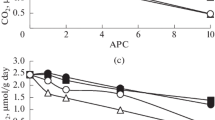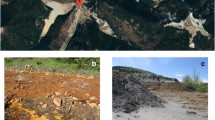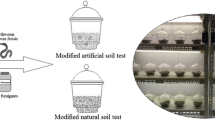Abstract
An assessment of Cd, Cu, Pb, and Zn in 25 soil samples collected near busy roads in Irbid city, Jordan indicated contamination of these soil samples with different concentrations of 624, 1.243, 242, and 847 µg/g for Pb, Cd, Cu, and Zn, respectively. The survival percentage of Drosophila melanogaster third-instar larvae on synthetic medium containing these concentrations for the first generation shows a significant reduction in their growth and development or metamorphosis for most soil extracts. Moreover, there was a significant reduction in survival growth and development in the second generation. The survival percentages of the second generation at pupa stage was higher than the first generation, whereas at the adult stage, there was a lower survival percentage indicating some effects on metamorphosis caused by concentration of heavy metals on Drosophila melanogaster.
Similar content being viewed by others
References
Ferguson J (1990) The heavy metal elements in the atmosphere. In: Ferguson JE (ed) Chemistry, Environmental Impact and Health Effects. Pergamon Press, UK
Largewerff J, Spetch A (1970) Contamination of roadside soil and vegetation in cadmium, nickel and zinc. Environ Sci Technol 4:583–586
Campos E, Barahona E, Lachica M, Mingorance M (1998) A study of the analytical parameters important for the sequential extraction procedure using microwave heating for Pb, Zn, and Cu in calcareous soils. Anal Chim Acta 369:235–243
Cameron R (1992) Guide to site and soil description of hazardous waste site characterization. Volume 1, Metals. Environmental Protection Agency EPA/600/4–91/029
World Health Organization, Inorganic Lead (1995) Environmental Health Criteria 165. International Programme on Chemical Safety. WHO, Geneva, Switzerland
Hapke H (1987) Thxikologie fur veterinarmedizine, 2nd edition. Enke-Verlag, Stuttgart
Underwood E (1977) Trace Elements in human and animal nutrition, 4th ed. Academic Press, Inc., New York
Gossel T, Bricker J (1990) Principles of clinical toxicology, 2nd edition. Ravan Press, New York, pp 135–195
Setwart W, Schwartz B, Simon D, Bolla K, Todd A, Links J (1999) Neurobehavioral function and tibial and chelatable lead levels in 543 former organolead workers. Neurology 52:1610–1617
Silar P, Theodore L, Mokdad R, Erraiss N, Cadic A, Wegnez M (1990) Metallothionein Mto gene of Drosophila melanogaster: structure and regulation. J Mol Biol 215:217–224
Echalier G (1997) Drosophila cells in culture. Academic Press, New York
De moor J, Koropatinickm D (2000) Metals and cellular signaling in mammalian cells. Cell Mol Biol 46:367–381
Kagi J, Kojima Y (1987) Chemistry and biochemistry of metallothionein. Experientia Suppl 52:25–61
Kagi J (1987) Overview of metallothionein methods. Enzymologia 205:613–626
Heuchel R, Radtke F, Georgiev O, Stark G, Aguet M, Scchaffner W (1994) The transcription factor MTF-1 is essential for basal and heavy metal induced metallothionein gene expression. EMBO J 13:2870−2875
Hensbergen P, Donker M, Hunziker P, Van der Schors R, Van Straalen N (2001) Two metals-binding peptides from the insect Orcheslla cincta (collembola) as a result of metallothionein cleavage. Insect Biochem Mol Biol 31:1105–1114
Bonneton F, Wegnez M (1995) Developmental variability of metallothionein Mtngene expression in the species of the Drosophila melanogaster subgroup. Dev Genet 16:253–263
Bonneton F, Theodore L, Silar P, Maroni G, Wegnez M (1996) Response of Drosophila metallothothionein promoters to metallic heat shock and oxidative stresses. FEBS Lett 380:33–38
Durliat M, Bonneton F, Boissonneau E, Andre MM, Wegnez M (1995) Expression of metallothionein genes during the post-embryonic development of Drosophila melanogaster. BioMetals 8:339–351
Lastowski-Perry D, Otto E, Maroni G (1985) Molecular and cytogenetic characterization of a metallothionein. J Biol Chem 260:1572–1530
Maroni G, Otto E, Lastowski-Perry D (1986) Molecular and cytogenetic characterization of a metallothionein. Genetics 112:493–504
Mokdad R, Debec A, Wegnez M (1987) Metallothionein genes in Drosophila melanogaster constitute a dual system. Proc Natl Acad Sci U S A 84:2658–2662
Mirth C, Riddiford L (2007) Size assessment and growth control: how adult size is determined in insects. Bioassays 29(4):344–355
Gefen E, Marlon A, Gibbs A (2006) Selection for desiccation resistance in adult Drosophila melanogaster affects larval development and metabolite accumulation. J Exp Biol 209(17):3293–3300
Massadeh A, Snook R (2001) Determination of Pb and Cd in road dusts. J Environ Monit 4:567–572
Ballan-Dufrancacis C (2002) Localization of Metals in Cells of Pterygote insects. Microsc Res. Tech 56:403–420
Acknowledgments
Thanks are due to the Jordan University of Science and Technology, Irbid-Jordan for introducing facilities. Many thanks also to Hokmia Al-Khateeb, Ibrahim Dukhnoosh, and Hazem Haddad for their technical assistance.
Author information
Authors and Affiliations
Corresponding author
Rights and permissions
About this article
Cite this article
Massadeh, A., Al-Momani, F. & Elbetieha, A. Assessment of Heavy Metals Concentrations in Soil Samples from the Vicinity of Busy Roads: Influence on Drosophila melanogaster Life Cycle. Biol Trace Elem Res 122, 292–299 (2008). https://doi.org/10.1007/s12011-007-8080-9
Received:
Accepted:
Published:
Issue Date:
DOI: https://doi.org/10.1007/s12011-007-8080-9




